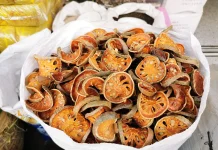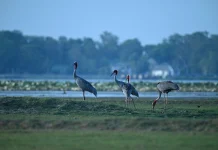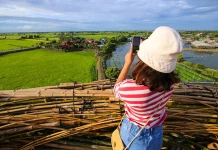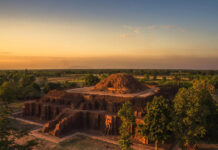Hue Royal Palace, also known as Hue Citadel, was built in 1805 by Emperor Gia Long, the founder of the Nguyen Dynasty, and finally completed in 1832 under the sovereignty of Emperor Ming Mang.
Located on the North bank of the Perfume River, the huge complex covers an area of 520 hectares and comprises three circles of ramparts: Hue Capital Citadel, Royal Citadel or Yellow Imperial City and Forbidden Citadel or Purple Forbidden City.
Crossing the stone bridge over the first moat, we come across the Nine Holy Canons, flanking the gates on either side of the Flag Tower.
“The bronze canons represent the Four Seasons and the Five Elements – earth, metal, wood, water and fire. They have never been used for military purposes. They just play a symbolic role as guardian spirits for the Citadel,” says Dang Lan, a former English teacher turned tour guide.
A second moat and defensive wall within the Citadel guard the Hoang Thanh or Yellow Imperial City, a replica of the Forbidden City in Beijing. This inner city has four gates, the most important of which is Cua Ngo Mon or the Noon Gate.


“The Noon Gate is also known as the Meridian Gate. It has five entrances – the central way was reserved for the emperor only. The two entrances flanking the central gate were for mandarins and court officials, while the outermost entrances were for soldiers and war materiel. Above the main gateways is the Five Phoenix Watchtower, the Emperor’s private viewing platform during important court ceremonies,” Dang Lan explains.
Behind the Noon Gate is the throne room of the Nguyen Kings, which is also known as the Palace of Supreme Harmony.
Directly behind the throne room is an access to the Purple Forbidden City, the royal residence for the emperor, his queen, concubines, and female palace servants. No one could enter or leave this 10-hectare city-within-a-city without the emperor’s permission.


The Royal Palace was severely damaged during the bombing of the city in 1968. The splendid sight of the defensive fort and the Yellow Imperial City still remain but most of the Purple Forbidden City, which once boasted many dozens of pavilions and hundreds of rooms, has now been given over to vast grass fields.
Three kilometres away from Hue Citadel, the Thien Mu Pagoda sits on the Ha Khe hill. The octagonal tower has seven storeys, each dedicated to a different Buddha, and overlooks the Perfume River.
“The Thien Mu Pagoda is the unofficial symbol of Hue. The temple behind the pagoda houses a national relic, the Austin motor vehicle which Thich Quang Duc drove to Saigon before setting himself alight at an intersection in downtown Saigon to protest against the Diem regime’s violations of religious freedom on June 11, 1963. His body was re-cremated during the funeral, but his heart remained intact. The heart is now placed in a glass chalice at XaLoi Pagoda in Saigon,” Dang Lan says.
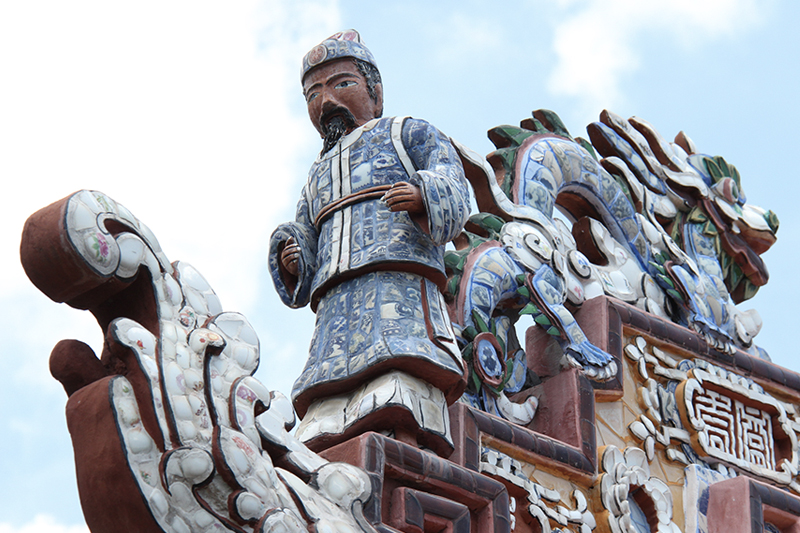
Southeast of Hue Citadel are seven royal tombs containing the remains of the Nguyen Dynasty rulers. Each tomb is built according to Vietnamese feng shui notions and decorated with stone elephants, horses and mandarins.
“The emperor would plan the tomb himself, since it would be his residence after his death. Emperor Tu Duc’s Tomb is interesting as he was the only one who used his tomb’s palace as a retreat when he was alive but after his death he was actually buried in a different, secret location somewhere in Hue, not in his own tomb,” says Dang Lan.
Tu Duc was the fourth of the 13 emperors in the Nguyen line but is often regarded as the last Emperor of Vietnam, since he was the last to rule independently.

His poetic spirit is reflected in the landscape and arrangement of a vast, sprawling complex set around a lake, with wooden pavilions and temples dedicated to wives and more than 100 concubines. The emperor’s tomb itself is surprisingly modest, tucked away in the back of the complex and boasting just a stone coffin in the middle of the final courtyard.
If Hue Royal Palace can be compared to the rising sun, then the Tu Duc Mausoleum can only be where the sun solemnly set.


